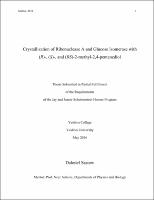Please use this identifier to cite or link to this item:
https://hdl.handle.net/20.500.12202/4044Full metadata record
| DC Field | Value | Language |
|---|---|---|
| dc.contributor.author | Sastow, Dahniel | |
| dc.date.accessioned | 2018-11-01T20:21:00Z | |
| dc.date.available | 2018-11-01T20:21:00Z | |
| dc.date.issued | 2016 | |
| dc.identifier.uri | https://hdl.handle.net/20.500.12202/4044 | |
| dc.identifier.uri | https://ezproxy.yu.edu/login?url=https://repository.yu.edu/handle/20.500.12202/4044 | |
| dc.description | The file is restricted for YU community access only. | |
| dc.description.abstract | Crystallizing proteins is challenging because it entails selecting appropriately a myriad of different variables. One of these variables is the type of precipitant used. Our lab uses a unique approach of using chiral precipitants to crystallize proteins. Chiral molecules are known to have slightly different properties from each other. These differences in chiral precipitants can affect the way proteins crystallize. In this study, the proteins ribonuclease A and glucose isomerase were crystallized in the presence of the chiral additive 2-methyl-2,4-pentanediol (MPD), using the (R) and (S) enantiomers as well as the racemic (RS) mixture. A wide range of experiments was done with ribonuclease A, exemplifying the many effects that chiral molecules can have on protein crystallization. Using the batch technique at 25°C, only (S)- MPD was found in crystals prepared in an (RS)-MPD solution. In a separate experiment with batch at 4°C, only crystals prepared with (R)-MPD formed, but with no MPD evident in the resulting crystals. In a microbatch experiment using an Oryx 8 robot, crystals were produced with each enantiomer, but the ribonuclease A crystallized with (S)-MPD took 1.5 months to crystallize compared to only one week with ribonuclease A crystallized with (R)-MPD. In both cases MPD was found in the crystal. A seeding experiment done with ribonuclease A showed that the crystal behavior is due to the solution and not the seed. For glucose isomerase, crystallization was carried out using only microbatch. By comparing crystals formed with (R)-, (S)-, and (RS)-MPD it became evident that there were two MPD binding sites, one that preferred (R)-MPD and one that preferred (S)-MPD. Unlike ribonuclease A, the differences in the overall resolution and quality of the crystals prepared with the different enantiomers were statistically insignificant. | en_US |
| dc.description.sponsorship | Jay and Jeanie Schottenstein Honors Program | en_US |
| dc.language.iso | en_US | en_US |
| dc.publisher | Yeshiva College | |
| dc.rights | Attribution-NonCommercial-NoDerivs 3.0 United States | * |
| dc.rights.uri | http://creativecommons.org/licenses/by-nc-nd/3.0/us/ | * |
| dc.subject | Proteins --Structure. | en_US |
| dc.subject | Proteins --Synthesis. | en_US |
| dc.subject | Proteins --Separation. | en_US |
| dc.subject | Crystallization. | en_US |
| dc.subject | Ribonucleases. | en_US |
| dc.subject | Xylose. | en_US |
| dc.title | Crystallization of Ribonuclease A and Glucose Isomerase with (R)-, (S)-, and (RS)-2-methyl-2,4-pentanediol | en_US |
| dc.type | Thesis | en_US |
| Appears in Collections: | Jay and Jeanie Schottenstein Honors Student Theses | |
Files in This Item:
| File | Description | Size | Format | |
|---|---|---|---|---|
| Dahniel-Sastow.pdf Restricted Access | 10.78 MB | Adobe PDF |  View/Open |
This item is licensed under a Creative Commons License

